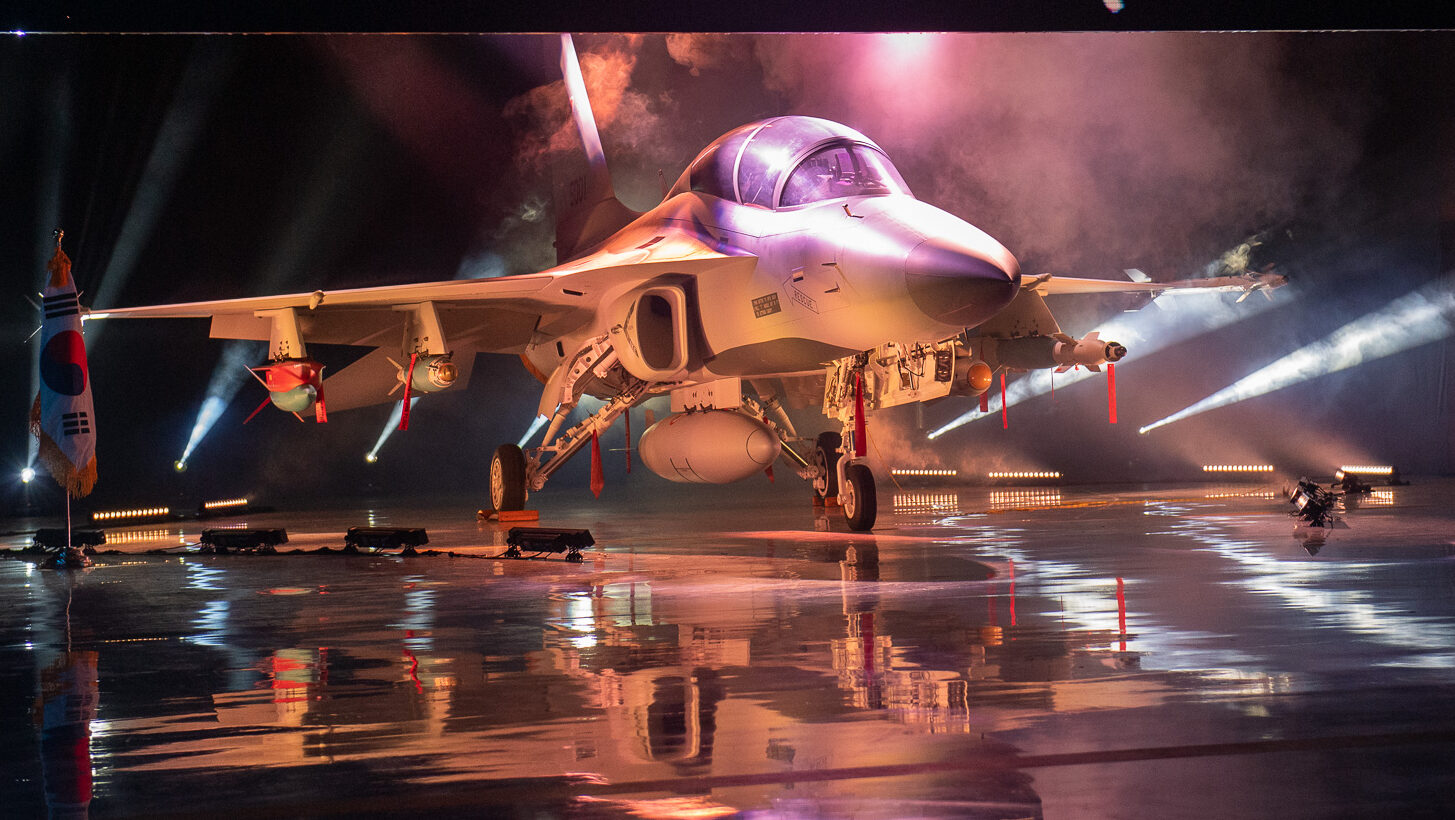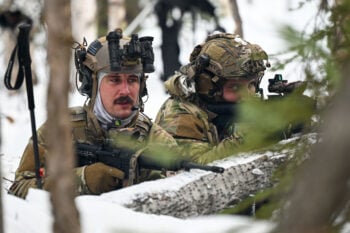
The official roll-out of the FA-50 for Poland occurred in early June 2023. (Polish MoD)
WARSAW — This week, Polish defense minister Mariusz Błaszczak paid a three-day visit to South Korea. Officially he spent that time discussing military cooperation and armaments industries between the two countries and observing the roll-out of the first FA-50 aircraft for Poland. But according to some Korean and Polish media, the most important part of this visit were talks to secure further loans in order to expand Poland’s already massive purchases of Korean-made weapons.
On the first day of his visit, June 5th, Błaszczak met with South Korean Defense Minister Lee Jong-sup, his Korean counterpart, and Eom Dong-Hwan, the Minister of the Defense Procurement Agency (DAPA). The politicians discussed the possibility of increasing the potential of the Polish Armed Forces as part of Polish-Korean cooperation. Błaszczak also met with Lim Jong-deuk, South Korea’s deputy national security adviser. “My task as the Minister of Defense is to strengthen the Polish Army, and thanks to cooperation with South Korea, we already have tangible effects of this,” Błaszczak said.
Korean equipment is among the most modern. The Ministry of National Defense negotiated good prices for this equipment,” stressed Błaszczak.
Glad handing aside, the real work seems to have occurred behind the scenes. While not confirmed by either government, South Korea media reported during the visit that a 12 trillion won (PLN 38.4 billion, over $9 billion) credit line has already been granted by Export–Import Bank of Korea to Poland last year, and that another, slightly smaller, tranche of loans is in the works.
A high-ranking government source told SBS television that it was “a proposal to be discussed in working-level negotiations” and that “it has not yet been finalized.”
Such negotiations certainly explains the presence the number two in the Polish delegation, former Minister of Finance Tadeusz Kościński, who since the middle of las tyear has served as the Secretary of State at the Chancellery of the Prime Minister, responsible for the sources of financing of Polish defense programs.
The fact that the arms deals will be financed from loans, credits, bonds and other forms of debt has been clearly announced by the Warsaw late 2021, with a special off-budget Armed Forces Support Fund established specifically for this purpose.
“The Ministry of National Defense negotiated good prices for this [Korean] equipment. Now the point is for Bank Gospodarstwa Krajowego to fill financial plans with content,” Błaszczak said this week.
If the second loan works out, totaling over PLN 70 billion ($17 billion), it will be enough for all the equipment contracted from Korea so far – 180 K2 tanks, 212 K9 howitzers, 48 FA-50 aircraft and 218 K239 launchers with ammunition. But it will be not enough money to cover the entire Polish-Korean strategic deal, which includes another 820 K2 tanks and 460 K9 howitzers.
RELATED: Poland’s massive tank, artillery and jet deal with S. Korea comes in shadow of Ukraine war
The Ministry of National Defense, when asked by Polish tabloid Fakt about Korean loans and the method of financing these weapons purchases, directed questions to Bank Gospodarstwa Krajowego, responsible for raising funds for large arms purchases. BGK in turn referred to the official reports for 2022 and informs that “detailed information on the financing of the Armed Forces Support Fund is covered by banking secrecy”.
“When there’s a mismatch between budgets and national security requirements, seller financing can help,” said Richard Aboulafia, an analyst with AeroDynamic Advisory. “It gets weapons to customers faster than waiting for their budgets to grow. Given the world security environment, it’s not surprising that this is becoming a bigger feature of the arms sales landscape.”
Aboulafia acknowledged that there is always risk in taking out a large loan for a major military purchase, but predicts Poland should end up fine in the end.
“Naturally, there’s risk here, but Poland is in solid shape, compared with, say, Myanmar or Venezuela” economically, he said. “The worst-case scenario would be a restructured payments schedule. Outright default would have extremely negative consequences for financing any capital goods in Poland, and the Polish economy is generally in sound shape.”
During the trip, Błaszczak met with Lee to sign a Memorandum of Understanding establishing a new group, known as the Joint Korean-Polish Committee (JKPC) on Cooperation in the Fields of Defence and Defence Industry. According to Poland’s MND, it will be composed of “six working groups whose task will be to strengthen military and education cooperation” as well as research and development.
“Cooperation between Poland and South Korea is very close. We have appointed a committee that consists of six groups, […] established on the Korean-American teams model. The point is that we should be in constant contact and exchange our comments on cooperation on an ongoing basis. We want to use the Korean-American cooperation model in Polish-American and with Korean partner cooperation,” Błaszczak explained.
Błaszczak and Lee also visited a training ground where they observed the actions of South Korean soldiers using the K239 Chunmoo rocket artillery system integrated with the Polish Jelcz chassis, K9 howitzers, K2 tanks, KAI KLH-1 Surion multi-role helicopters, AAGW artillery anti-aircraft systems, AAV7 amphibious vehicles, K21 and AS21 Redback IFVs, AH-64 attack helicopters, F-35 multi-role aircraft and other equipment.
“We saw a show of force, which is very important when it comes to deterring the aggressor,” commented Błaszczak. He highlighted the importance of how interoperable the South Korean FA-50s are with F-16 aircraft, as well as the K2 tanks and K9 howitzers with equipment manufactured in the US. “This is what we want, this is our goal in Poland,” Błaszczak stated.
Polish FA-50 Roll-Out
While in South Korea, Błaszczak attended the June 7th official roll-out of the first FA-50 for Polish Air Force. Poland has ordered 48 aircraft, of which 12 are to be delivered later this year.
“We are in the process of negotiating the establishing of a service center in Poland based on cooperation between Korea Aerospace Industries and the Polish Armaments Group,” Błaszczak stated during the rollout.
FA-50 will enhance the potential of🇵🇱Air Force.
–
Deputy Prime Minister @mblaszczak: It is pivotal moment for the 🇵🇱Air Force. We dispose of post-soviet era aircraft, Polish Air Force will use solely F-16 and FA-50 from now on and quite soon, also F-35.📝https://t.co/1sSBNlUq3z https://t.co/oiSwzglTRt pic.twitter.com/JMCHtgSkFH
— Poland MOD 🇵🇱 (@Poland_MOD) June 7, 2023
All FA-50s will be delivered to the 23rd Tactical Air Base in Mińsk Mazowiecki starting Q3 of 2023, with deliveries running through the end of the year. A full mission simulator will be ready to use in 2024, and the base is currently undergoing improvements and renovations to accommodate the aircraft. In 2025 deliveries of another batch of 36 FA-50PL light combat aircraft should start, and will be completed by the end of 2028.
The first group of four Polish pilots began training in South Korea in January. Three of them are ex-MiG-29 Fulcrum pilots and the fourth is ex-PZL-130 Orlik pilot. After ground school at KAI facilities, they are now going through training with South Korea’s 1st Fighter Wing at Gwangju, participating in a 23-week training program; they are expected to finish their training by July 21st.
A second group of four pilots, including one woman, deployed to South Korea in April to begin their training program; they are expected to return in November. Groups of technicians have also been deployed to South Korea in order to learn how to maintain the aircraft.
In Mid-May it was announced that these aircraft will be equipped with Raytheon Technologies PhantomStrike radar, approved by the US to be exported as a Direct Commercial Sales product to KAI. Per the company, PhantomStrike combines “a gallium nitride-powered array and the compact high-reliability integrated receiver/exciter processor … to match the capability of modern AESA radars.” Production of the radars will take place in US and Scotland, with support from Raytheon UK.
Polish Air Force FA-50s will also be equipped with Lockheed Martin’s Sniper Advanced Targeting Pod, which the US state department has approved for sale via the Foreign Military Sale process.
TAI exec claims 20 Turkish KAAN fighters to be delivered in 2028
Temel Kotil, TAI’s general manager, claimed that the domestically-produced Turkish jet will outperform the F-35 Joint Strike Fighter.


























